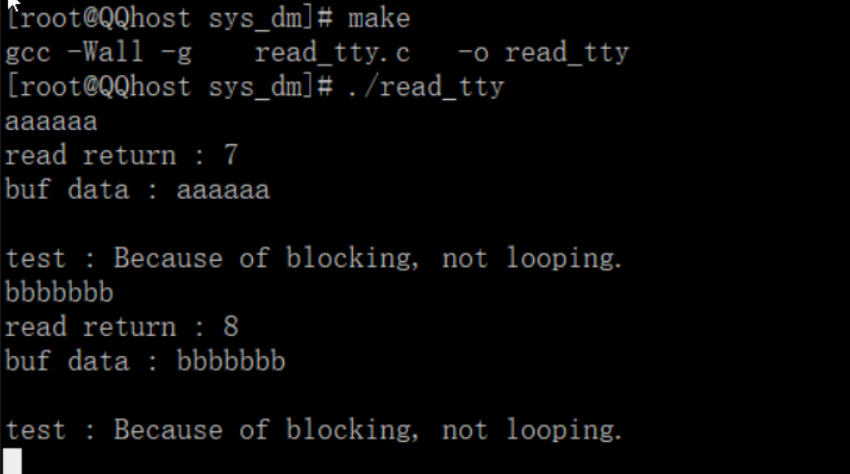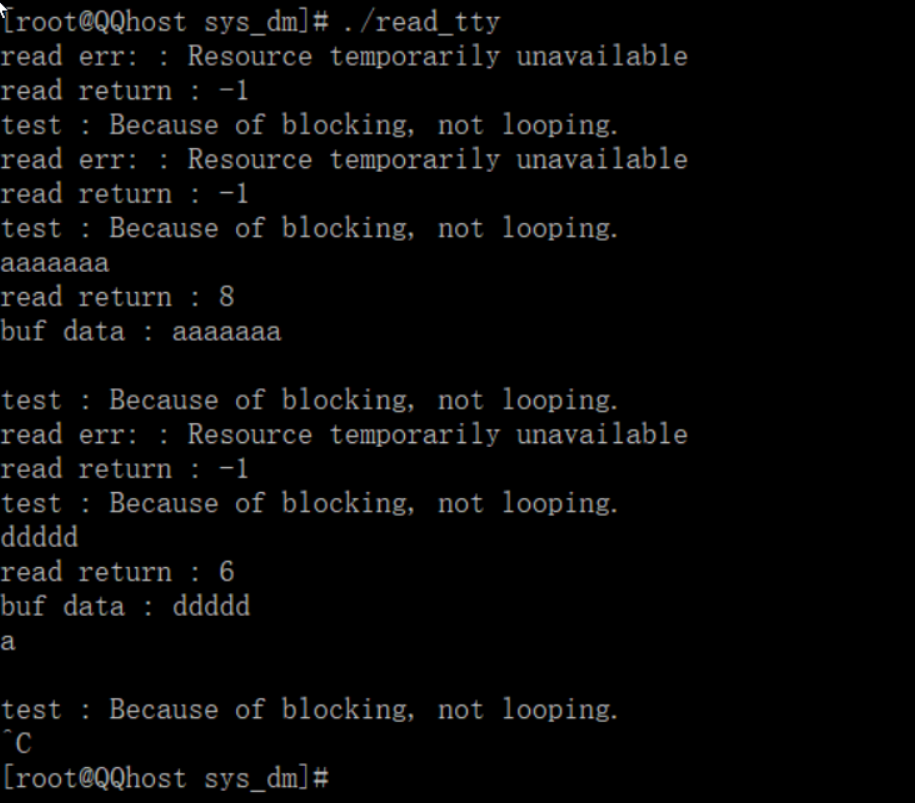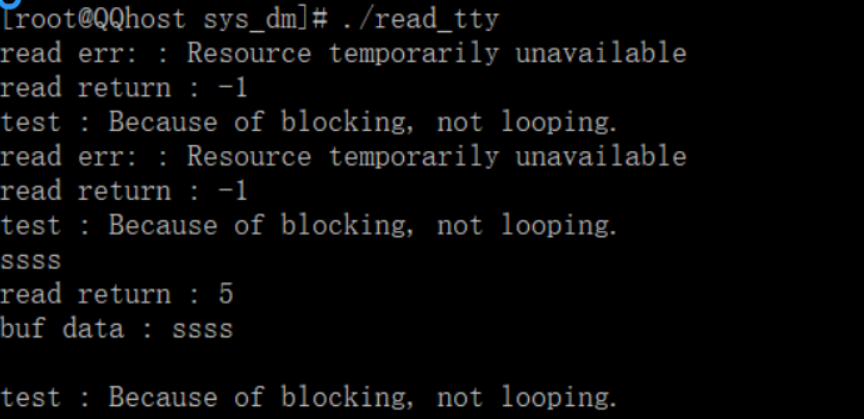🚀1. 阻塞与非阻塞概念
阻塞可能会发生在read()函数读取设备、读取管道或读取网络的时候,因为某种情况需要等待,而不会立即返回,叫做阻塞。下面通过read()读设备来演示,比如读输入输出设备 /dev/tty 。
我们先写一个测试函数来看一下阻塞的效果,让read()函数读取标准输入输出设备tty的内容,如果标准输入输出没有内容的话,read()函数就会被阻塞,直到tty有内容了,才会继续执行。
/************************************************************
>File Name : read_tty.c
>Author : QQ
>Company : QQ
>Create Time: 2022年05月13日 星期五 22时22分00秒
************************************************************/
#include <stdio.h>
#include <stdlib.h>
#include <sys/types.h>
#include <unistd.h>
#include <fcntl.h>
#include <string.h>
int main()
{
int fd = open("/dev/tty", O_RDONLY);
char buf[100];
memset(buf, 0, sizeof(buf));
while(1)
{
int ret = read(fd, buf, sizeof(buf));
printf("read return : %d\n", ret);
if(ret > 0)
{
printf("buf data : %s\n", buf);
}
printf("test : Because of blocking, not looping.\n");
}
close(fd);
return 0;
}
这里的printf(“test…”)这句话主要是为了证明程序在阻塞,而不是在无限循环,假如程序暂停时没有打印这句话,说明程序还没有执行到这句话。下面编译运行一下,看一下效果。

通过运行结果可以看到,程序会卡住不动,直到我们在标准输入输出设备上输入内容,程序才会执行一个循环,并把我们输入的内容读出来。这就是阻塞,read()因为tty为空读不到内容,所以阻塞等待tty有内容。在这种状态下可以按ctrl+c来发信号退出。

这就是阻塞的效果,阻塞时整个程序卡在那不动,其实是很浪费资源的,下面我们看一下非阻塞的效果。下面先对之前的程序进行改动一下,通过open()函数的O_NONBLOCK参数来实现非阻塞打开文件。
int main()
{
int fd = open("/dev/tty", O_RDONLY | O_NONBLOCK); /*加O_NONBLOCK参数实现非阻塞*/
char buf[100];
memset(buf, 0, sizeof(buf));
while(1)
{
int ret = read(fd, buf, sizeof(buf));
if(ret < 0)
{
perror("read err: "); /*打印出错信息,read函数返回失败的时候会设置errno*/
}
printf("read return : %d\n", ret);
if(ret > 0)
{
printf("buf data : %s\n", buf);
}
printf("test : Because of blocking, not looping.\n");
sleep(2); /*睡眠2秒,不然的话会一直刷屏*/
}
close(fd);
return 0;
}
非阻塞的情况下,如果read()函数读取不到内容,那么它不会阻塞在原地,而是会返回失败-1并设置errno 。因为是非阻塞,所以函数体内的循环会一直执行无限循环,所以要加一个睡眠函数,防止刷屏。

执行后可以看到,由于是非阻塞的方式打开tty设备,所以程序一直在循环执行,如果我们不向tty标准输入输出设备输入内容的话,read()会返回-1,并打印出一条出错信息 “Resource temporarily unavailable” ,然后继续执行下一次循环(如果是阻塞的方式打开文件,read()函数读取不到内容会暂停),如果我们输入内容,read()函数会把我们输入的内容读取出来并返回读取的字节数。
🚀2. fcntl函数设置非阻塞
- 包含头文件
#include <unistd.h>
#include <fcntl.h>
- 函数原型
int fcntl(int fd, int cmd, ... /* arg */ );
-
函数功能
fcntl() performs one of the operations described below on the open file descriptor fd. The operation is determined by cmd. 打开一个文件描述符,操作由cmd来决定。这个函数功能还是很多的,可以通过 man 2 fcntl 来查看。
-
函数参数
它是一个可变参数的函数,… /* arg */ 的内容取决于cmd,比较常用的两个如下
- 获取标志:F_GETFL (void) Read the file status flags; arg is ignored. 也就是说,如果cmd选择F_GETFL的话,后面参数可以为void,也就是没有第三个参数
- 设置标志:F_SETFL (long) Set the file status flags to the value specified by arg. File access mode (O_RDONLY, O_WRONLY, O_RDWR) and file creation flags (i.e., O_CREAT, O_EXCL, O_NOCTTY, O_TRUNC) in arg are ignored. On Linux this command can only change the O_APPEND, O_ASYNC, O_DIRECT, O_NOATIME, and O_NONBLOCK flags. 这个的话,如果cmd是F_SETFL,那么后边参数应该是long类型的
-
函数返回值
F_GETFL Value of flags. 如果我们使用的cmd参数是F_GETFL 那么就会把获取的标志返回出来。实际上,fcntl()函数的返回值也是由cmd参数来决定的,这只是比较常用的一个,更多的返回值可以在man手册查询。
下面我们通过实例来说明这个函数的用法,接上一节的话题,我们可以不在open()打开文件的时候设置非阻塞,而是在程序中使用fcntl()函数来设置非阻塞参数,具体代码如下。
int main()
{
int fd = open("/dev/tty", O_RDONLY);
/*第一次调用,使用F_GETFL来获取标志,并通过返回值返回*/
int flag = fcntl(fd, F_GETFL);
/*把标志重新设置,通过或运算置非阻塞位*/
flag |= O_NONBLOCK;
/*第二次调用,使用F_SETFL参数来设置标志位,把上面修改好的标志在设置回文件*/
fcntl(fd, F_SETFL, flag);
char buf[100];
memset(buf, 0, sizeof(buf));
while(1)
{
int ret = read(fd, buf, sizeof(buf));
if(ret < 0)
{
perror("read err: ");
}
printf("read return : %d\n", ret);
if(ret > 0)
{
printf("buf data : %s\n", buf);
}
printf("test : Because of blocking, not looping.\n");
sleep(2);
}
close(fd);
return 0;
}
在这里通过fcntl()函数三行代码也实现了非阻塞打开文件的效果,和上面的open()直接加参数O_NONBLOCK效果是一样的。

这个函数功能是非常多的,这里只介绍用于设置非阻塞这一个功能,其他功能在后面用到时介绍。



